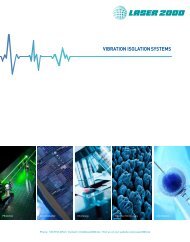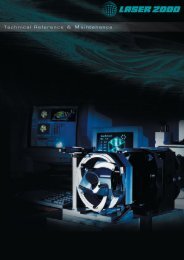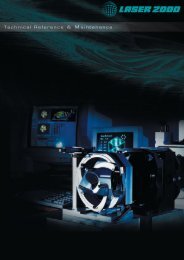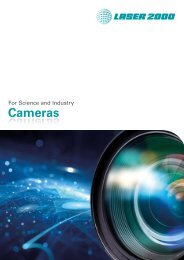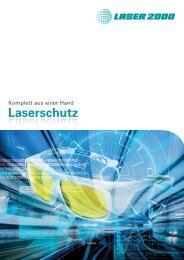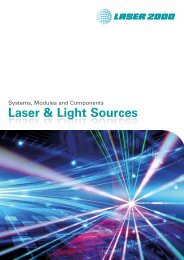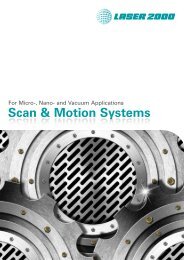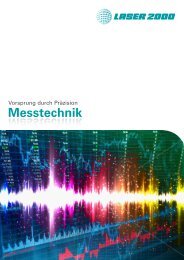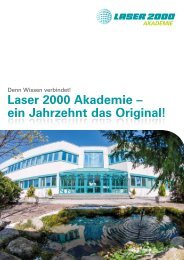Semrock Master Catalog 2018
Semrock Master Catalog 2018
Semrock Master Catalog 2018
You also want an ePaper? Increase the reach of your titles
YUMPU automatically turns print PDFs into web optimized ePapers that Google loves.
Near Infrared Bandpass Filters<br />
Transmission (%)<br />
100<br />
90<br />
80<br />
70<br />
60<br />
50<br />
40<br />
30<br />
20<br />
10<br />
Center<br />
Wavelength<br />
1535 1550 1570<br />
0<br />
1500 1510 1520 1530 1540 1550 1560 1570 1580 1590 1600<br />
Wavelength (nm)<br />
Transmission &<br />
Bandwidth<br />
Design<br />
Spectra<br />
1535 nm > 90% over 3 nm 6.8 nm<br />
1550 nm > 90% over 3 nm 8.8 nm<br />
1570 nm > 90% over 3 nm 8.9 nm<br />
Nominal<br />
Full-width,<br />
Half-Maximum<br />
LDT specification = 1 J/cm² @1570 nm (10 ns pulse width)<br />
Measuring Light with Wavelengths and Wavenumbers<br />
The “color” of light is generally identified by the distribution<br />
of power or intensity as a function of wavelength λ.<br />
For example, visible light has a wavelength that ranges from<br />
about 400 nm to just over 700 nm. However, sometimes<br />
it is convenient to describe light in terms of units called<br />
“wavenumbers,” where the wavenumber w is typically<br />
measured in units of cm -1 (“inverse centimeters”) and is<br />
simply equal to the inverse of the wavelength:<br />
In applications like Raman spectroscopy, often both wavelength<br />
and wavenumber units are used together, leading to<br />
potential confusion. For example, laser lines are generally<br />
identified by wavelength, but the separation of a particular<br />
Raman line from the laser line is generally given by a<br />
“wavenumber shift” ∆w, since this quantity is fixed by the<br />
molecular properties of the material and independent of<br />
which laser wavelength is used to excite the line.<br />
200 300 400 500 600<br />
<strong>Semrock</strong>’s industry-leading ion-beam-sputtering manufacturing is now available for<br />
making optical filters with precise spectral features (sharp edges, passbands, etc.) at<br />
near-IR wavelengths, with features out to ~ 1700 nm, and high transmission to wavelengths<br />
> 2000 nm. The bandpass filters on this page are ideal as laser source clean-up filters<br />
and as detection filters which pass particular laser wavelengths and virtually eliminate<br />
background over the full InGaAs detector range (850 – 1750 nm). They are optimized for<br />
the most popular “retina-safe” lasers in the 1.5 μm wavelength range, where maximum<br />
permissible eye exposures are much higher than in the visible or at the 1.06 μm neodymium<br />
line. Applications include laser radar, remote sensing, rangefinding, and laser-induced<br />
breakdown spectroscopy (LIBS).<br />
Near-IR bandpass filters are a good match for Er-doped fiber and Er-doped glass lasers at 1535 nm, r-doped fiber and InGaAsP semiconductor lasers at<br />
1550 nm, and Nd:YAG-pumped optical parametric oscillators (OPO’s) at 1570 nm.<br />
OD 5<br />
Blocking Range<br />
850 – 1519 nm<br />
1550 – 1750 nm<br />
850 – 1534 nm<br />
1565 – 1750 nm<br />
850 – 1554 nm<br />
1585 – 1750 nm<br />
When speaking of a “shift” from a first known wavelength λ 1<br />
to a second known wavelength λ 2<br />
, the resulting wavelength<br />
shift ∆λ is given by<br />
whereas the resulting wavenumber shift ∆w is given by<br />
When speaking of a known wavenumber shift ∆w from a<br />
first known wavelength λ 1<br />
, the resulting second wavelength<br />
λ 2<br />
is given by<br />
Note that when the final wavelength λ 2<br />
is longer than the<br />
initial wavelength λ 1<br />
, which corresponds to a “red shift,” in<br />
the above equations ∆w < 0, consistent with a shift toward<br />
smaller values of w. However, when the final wavelength λ 2<br />
is shorter than the initial wavelength λ 1<br />
, which corresponds<br />
to a “blue shift,” ∆w > 0, consistent with a shift toward<br />
larger values of w.<br />
Wavenumbers (cm -1 )<br />
50,000 33,333 25,000 20,000 16,667 14,286 12,500 11,111 10,000 9,091 8,333<br />
700<br />
Wavelength (nm)<br />
OD 6<br />
Blocking Range Part Number Price<br />
1412 – 1512 nm<br />
1558 – 1688 nm<br />
1426 – 1526 nm<br />
1573 – 1705 nm<br />
1444 – 1546 nm<br />
1593 – 1727 nm<br />
NIR01-1535/3-25 $610<br />
NIR01-1550/3-25 $610<br />
NIR01-1570/3-25 $610<br />
Except for the transmission, bandwidth, and blocking specifications listed above, all other specifications are identical to MaxLine ® specifications on page 99.<br />
TECHNICAL NOTE<br />
800 900 1000 1100 1200<br />
NIR Filters Mirrors Polarizers<br />
Edge<br />
Filters<br />
Dichroic<br />
Beamsplitters<br />
Laser-line<br />
Filters<br />
Laser Diode<br />
Filters<br />
Notch<br />
Filters<br />
Lamp Clean-up<br />
Filters<br />
UV<br />
Near-UV<br />
Visible<br />
Near-IR<br />
101<br />
More



